INDU1130: Evaluating International HRM's Effect on Performance
VerifiedAdded on 2023/06/12
|8
|2471
|340
Essay
AI Summary
This essay examines the relationship between international Human Resource Management (HRM) practices and organizational performance, drawing from studies in the 1990s and contemporary data from multinational corporations (MNCs). It defines HRM and international HRM, highlighting the components and functions of international HRM, including resourcing, performance management, reward management, training and development, and employee relations. The essay explores different approaches to HR implementation, such as best-practice, best-fit, and resource-based views, emphasizing the importance of training and development in enhancing a company's competitive advantage and labor productivity. It also discusses the role of employee relations and trade unions in fostering job satisfaction and productivity, comparing the approaches in China and the United States. The conclusion emphasizes the strategic and international inclination of modern HRM practices aimed at responding to global technology changes and competitiveness, supporting corporate social responsibility, and fostering long-term employment.
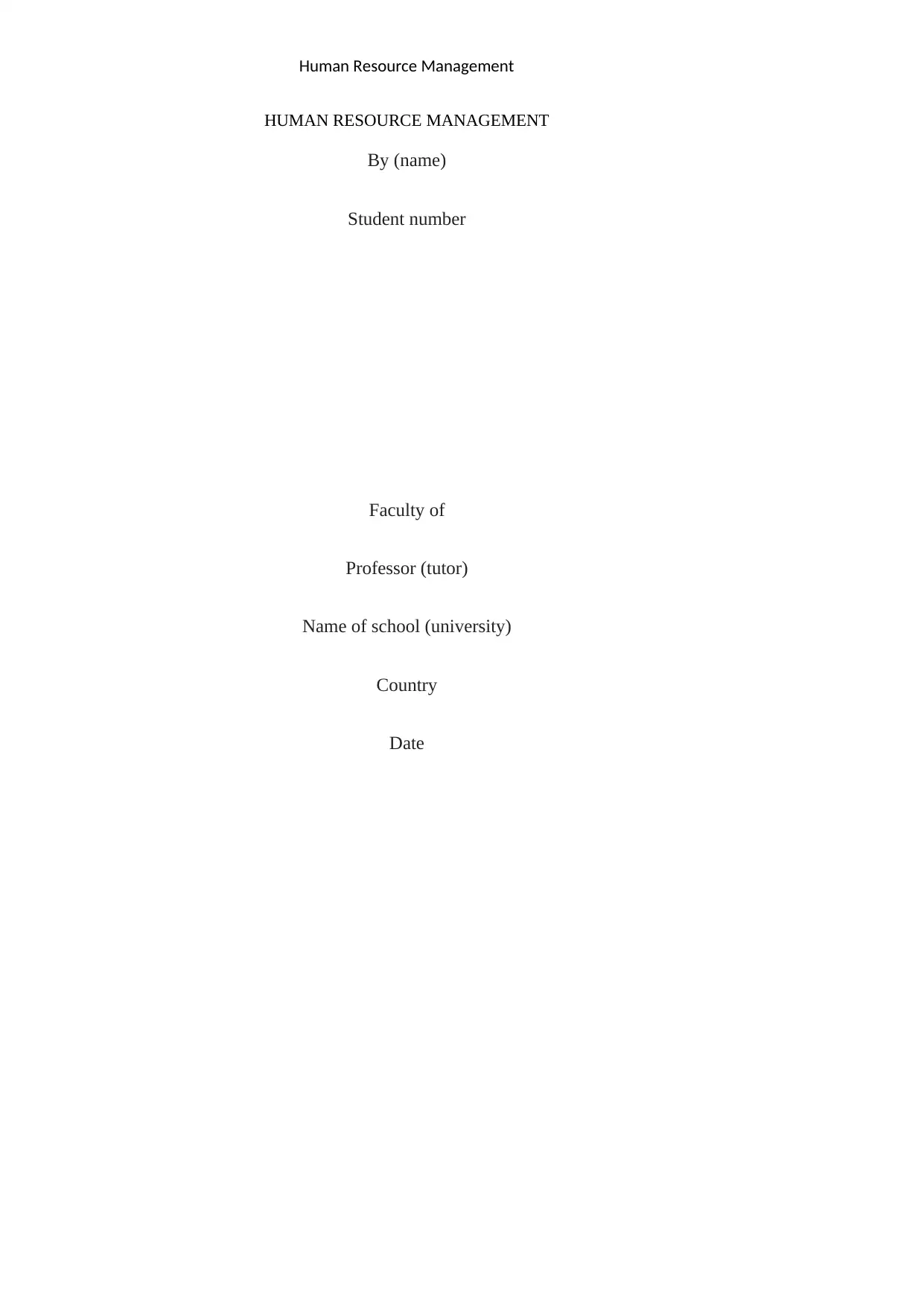
Human Resource Management
HUMAN RESOURCE MANAGEMENT
By (name)
Student number
Faculty of
Professor (tutor)
Name of school (university)
Country
Date
HUMAN RESOURCE MANAGEMENT
By (name)
Student number
Faculty of
Professor (tutor)
Name of school (university)
Country
Date
Paraphrase This Document
Need a fresh take? Get an instant paraphrase of this document with our AI Paraphraser
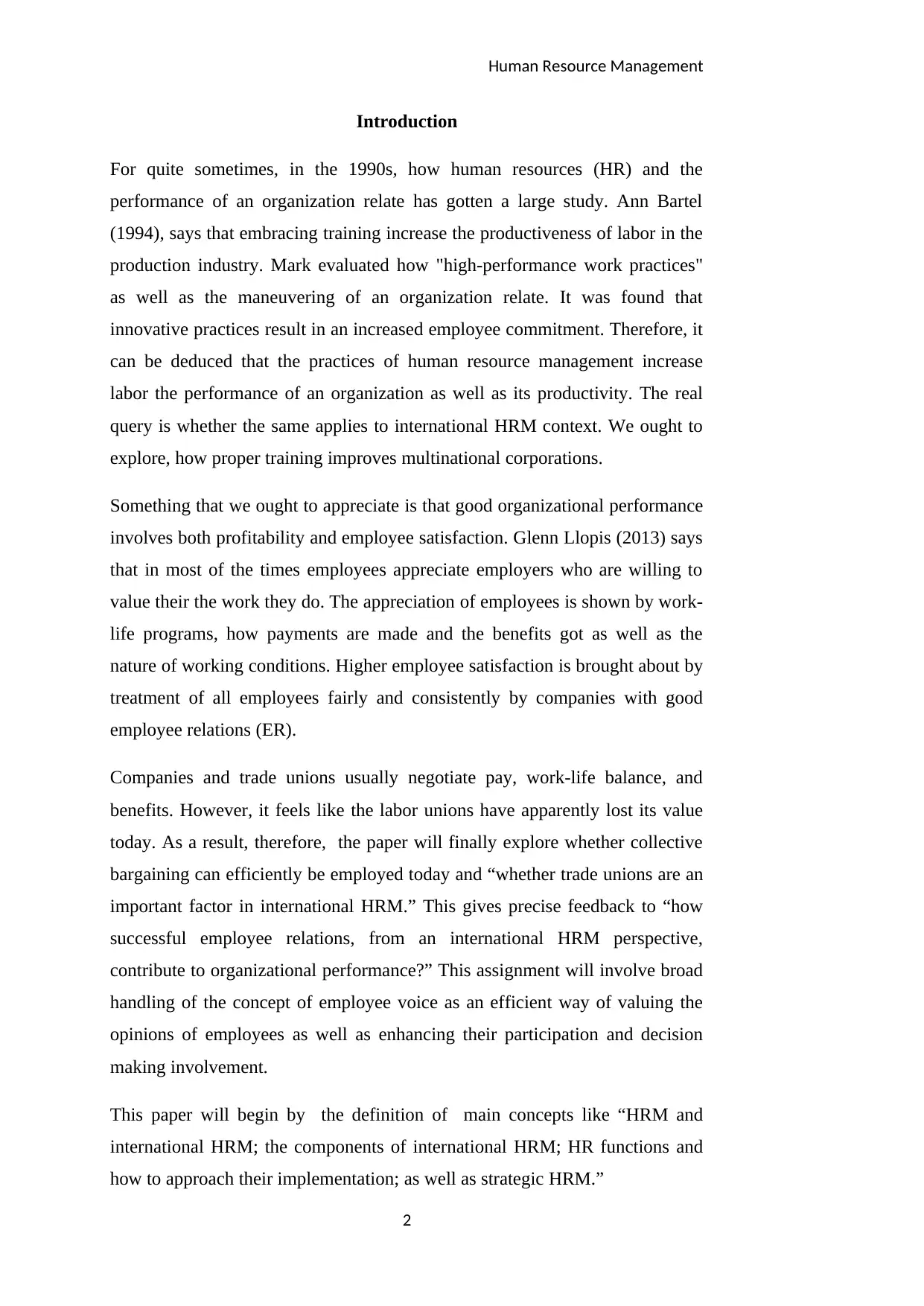
Human Resource Management
Introduction
For quite sometimes, in the 1990s, how human resources (HR) and the
performance of an organization relate has gotten a large study. Ann Bartel
(1994), says that embracing training increase the productiveness of labor in the
production industry. Mark evaluated how "high-performance work practices"
as well as the maneuvering of an organization relate. It was found that
innovative practices result in an increased employee commitment. Therefore, it
can be deduced that the practices of human resource management increase
labor the performance of an organization as well as its productivity. The real
query is whether the same applies to international HRM context. We ought to
explore, how proper training improves multinational corporations.
Something that we ought to appreciate is that good organizational performance
involves both profitability and employee satisfaction. Glenn Llopis (2013) says
that in most of the times employees appreciate employers who are willing to
value their the work they do. The appreciation of employees is shown by work-
life programs, how payments are made and the benefits got as well as the
nature of working conditions. Higher employee satisfaction is brought about by
treatment of all employees fairly and consistently by companies with good
employee relations (ER).
Companies and trade unions usually negotiate pay, work-life balance, and
benefits. However, it feels like the labor unions have apparently lost its value
today. As a result, therefore, the paper will finally explore whether collective
bargaining can efficiently be employed today and “whether trade unions are an
important factor in international HRM.” This gives precise feedback to “how
successful employee relations, from an international HRM perspective,
contribute to organizational performance?” This assignment will involve broad
handling of the concept of employee voice as an efficient way of valuing the
opinions of employees as well as enhancing their participation and decision
making involvement.
This paper will begin by the definition of main concepts like “HRM and
international HRM; the components of international HRM; HR functions and
how to approach their implementation; as well as strategic HRM.”
2
Introduction
For quite sometimes, in the 1990s, how human resources (HR) and the
performance of an organization relate has gotten a large study. Ann Bartel
(1994), says that embracing training increase the productiveness of labor in the
production industry. Mark evaluated how "high-performance work practices"
as well as the maneuvering of an organization relate. It was found that
innovative practices result in an increased employee commitment. Therefore, it
can be deduced that the practices of human resource management increase
labor the performance of an organization as well as its productivity. The real
query is whether the same applies to international HRM context. We ought to
explore, how proper training improves multinational corporations.
Something that we ought to appreciate is that good organizational performance
involves both profitability and employee satisfaction. Glenn Llopis (2013) says
that in most of the times employees appreciate employers who are willing to
value their the work they do. The appreciation of employees is shown by work-
life programs, how payments are made and the benefits got as well as the
nature of working conditions. Higher employee satisfaction is brought about by
treatment of all employees fairly and consistently by companies with good
employee relations (ER).
Companies and trade unions usually negotiate pay, work-life balance, and
benefits. However, it feels like the labor unions have apparently lost its value
today. As a result, therefore, the paper will finally explore whether collective
bargaining can efficiently be employed today and “whether trade unions are an
important factor in international HRM.” This gives precise feedback to “how
successful employee relations, from an international HRM perspective,
contribute to organizational performance?” This assignment will involve broad
handling of the concept of employee voice as an efficient way of valuing the
opinions of employees as well as enhancing their participation and decision
making involvement.
This paper will begin by the definition of main concepts like “HRM and
international HRM; the components of international HRM; HR functions and
how to approach their implementation; as well as strategic HRM.”
2
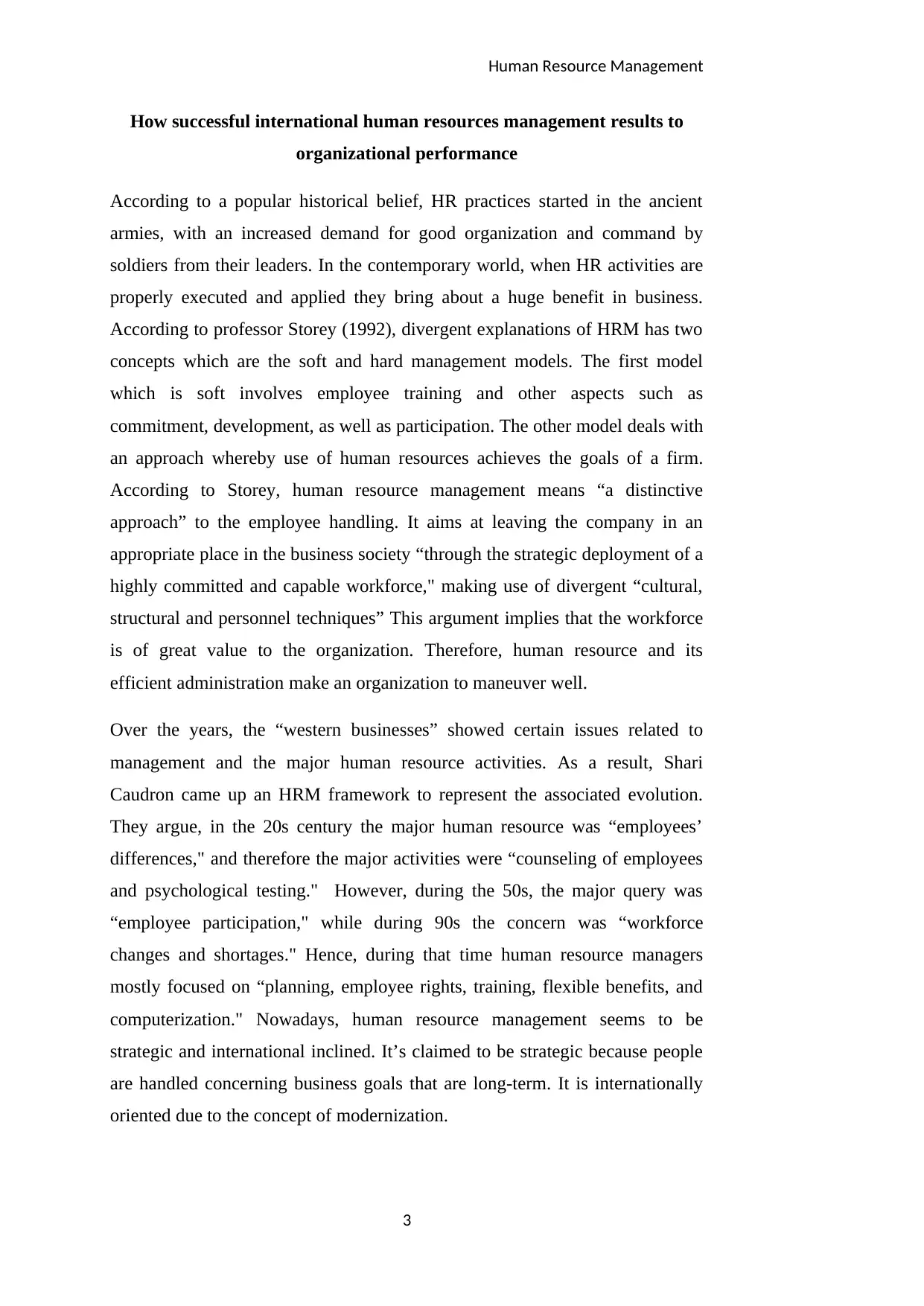
Human Resource Management
How successful international human resources management results to
organizational performance
According to a popular historical belief, HR practices started in the ancient
armies, with an increased demand for good organization and command by
soldiers from their leaders. In the contemporary world, when HR activities are
properly executed and applied they bring about a huge benefit in business.
According to professor Storey (1992), divergent explanations of HRM has two
concepts which are the soft and hard management models. The first model
which is soft involves employee training and other aspects such as
commitment, development, as well as participation. The other model deals with
an approach whereby use of human resources achieves the goals of a firm.
According to Storey, human resource management means “a distinctive
approach” to the employee handling. It aims at leaving the company in an
appropriate place in the business society “through the strategic deployment of a
highly committed and capable workforce," making use of divergent “cultural,
structural and personnel techniques” This argument implies that the workforce
is of great value to the organization. Therefore, human resource and its
efficient administration make an organization to maneuver well.
Over the years, the “western businesses” showed certain issues related to
management and the major human resource activities. As a result, Shari
Caudron came up an HRM framework to represent the associated evolution.
They argue, in the 20s century the major human resource was “employees’
differences," and therefore the major activities were “counseling of employees
and psychological testing." However, during the 50s, the major query was
“employee participation," while during 90s the concern was “workforce
changes and shortages." Hence, during that time human resource managers
mostly focused on “planning, employee rights, training, flexible benefits, and
computerization." Nowadays, human resource management seems to be
strategic and international inclined. It’s claimed to be strategic because people
are handled concerning business goals that are long-term. It is internationally
oriented due to the concept of modernization.
3
How successful international human resources management results to
organizational performance
According to a popular historical belief, HR practices started in the ancient
armies, with an increased demand for good organization and command by
soldiers from their leaders. In the contemporary world, when HR activities are
properly executed and applied they bring about a huge benefit in business.
According to professor Storey (1992), divergent explanations of HRM has two
concepts which are the soft and hard management models. The first model
which is soft involves employee training and other aspects such as
commitment, development, as well as participation. The other model deals with
an approach whereby use of human resources achieves the goals of a firm.
According to Storey, human resource management means “a distinctive
approach” to the employee handling. It aims at leaving the company in an
appropriate place in the business society “through the strategic deployment of a
highly committed and capable workforce," making use of divergent “cultural,
structural and personnel techniques” This argument implies that the workforce
is of great value to the organization. Therefore, human resource and its
efficient administration make an organization to maneuver well.
Over the years, the “western businesses” showed certain issues related to
management and the major human resource activities. As a result, Shari
Caudron came up an HRM framework to represent the associated evolution.
They argue, in the 20s century the major human resource was “employees’
differences," and therefore the major activities were “counseling of employees
and psychological testing." However, during the 50s, the major query was
“employee participation," while during 90s the concern was “workforce
changes and shortages." Hence, during that time human resource managers
mostly focused on “planning, employee rights, training, flexible benefits, and
computerization." Nowadays, human resource management seems to be
strategic and international inclined. It’s claimed to be strategic because people
are handled concerning business goals that are long-term. It is internationally
oriented due to the concept of modernization.
3
⊘ This is a preview!⊘
Do you want full access?
Subscribe today to unlock all pages.

Trusted by 1+ million students worldwide
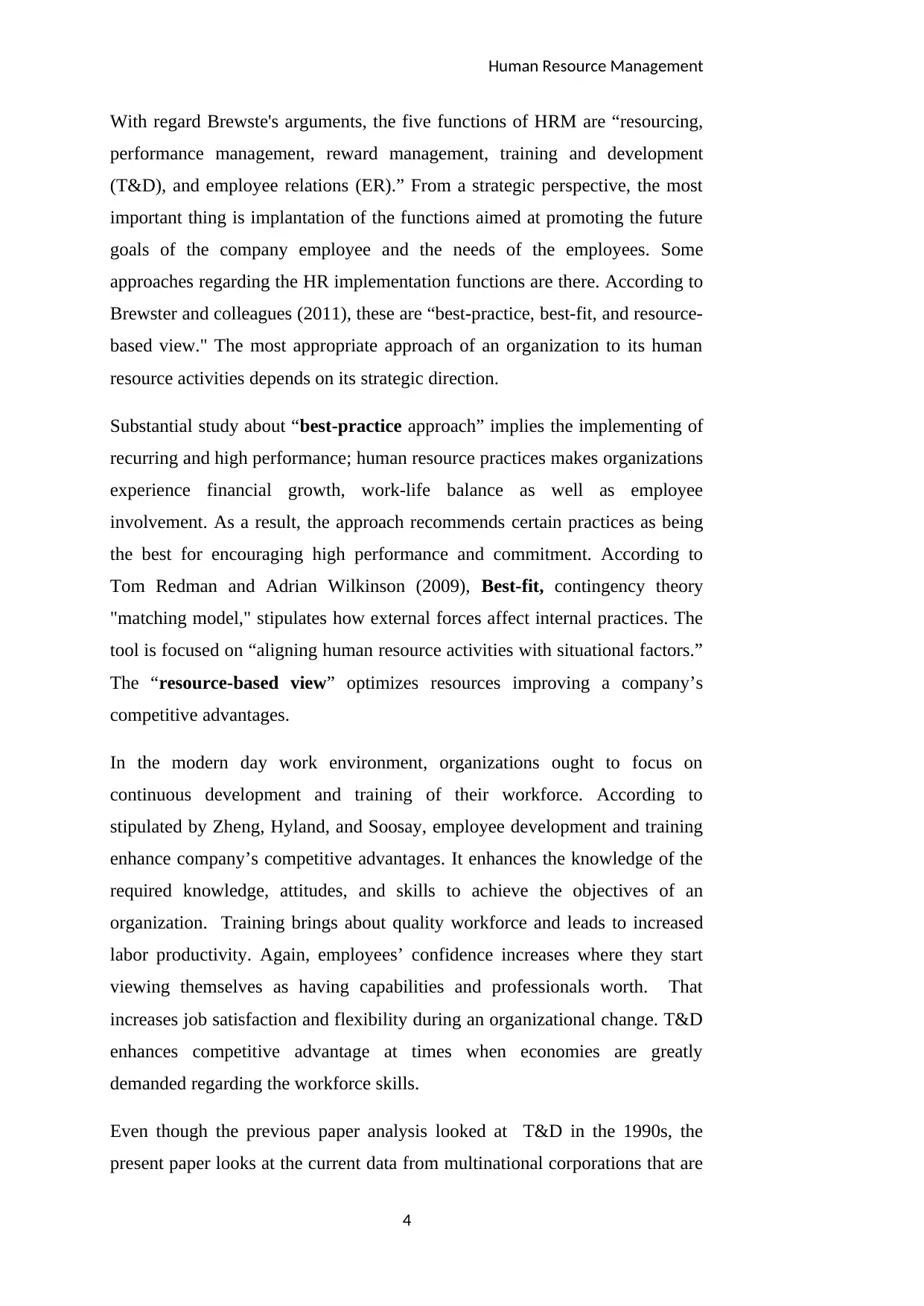
Human Resource Management
With regard Brewste's arguments, the five functions of HRM are “resourcing,
performance management, reward management, training and development
(T&D), and employee relations (ER).” From a strategic perspective, the most
important thing is implantation of the functions aimed at promoting the future
goals of the company employee and the needs of the employees. Some
approaches regarding the HR implementation functions are there. According to
Brewster and colleagues (2011), these are “best-practice, best-fit, and resource-
based view." The most appropriate approach of an organization to its human
resource activities depends on its strategic direction.
Substantial study about “best-practice approach” implies the implementing of
recurring and high performance; human resource practices makes organizations
experience financial growth, work-life balance as well as employee
involvement. As a result, the approach recommends certain practices as being
the best for encouraging high performance and commitment. According to
Tom Redman and Adrian Wilkinson (2009), Best-fit, contingency theory
"matching model," stipulates how external forces affect internal practices. The
tool is focused on “aligning human resource activities with situational factors.”
The “resource-based view” optimizes resources improving a company’s
competitive advantages.
In the modern day work environment, organizations ought to focus on
continuous development and training of their workforce. According to
stipulated by Zheng, Hyland, and Soosay, employee development and training
enhance company’s competitive advantages. It enhances the knowledge of the
required knowledge, attitudes, and skills to achieve the objectives of an
organization. Training brings about quality workforce and leads to increased
labor productivity. Again, employees’ confidence increases where they start
viewing themselves as having capabilities and professionals worth. That
increases job satisfaction and flexibility during an organizational change. T&D
enhances competitive advantage at times when economies are greatly
demanded regarding the workforce skills.
Even though the previous paper analysis looked at T&D in the 1990s, the
present paper looks at the current data from multinational corporations that are
4
With regard Brewste's arguments, the five functions of HRM are “resourcing,
performance management, reward management, training and development
(T&D), and employee relations (ER).” From a strategic perspective, the most
important thing is implantation of the functions aimed at promoting the future
goals of the company employee and the needs of the employees. Some
approaches regarding the HR implementation functions are there. According to
Brewster and colleagues (2011), these are “best-practice, best-fit, and resource-
based view." The most appropriate approach of an organization to its human
resource activities depends on its strategic direction.
Substantial study about “best-practice approach” implies the implementing of
recurring and high performance; human resource practices makes organizations
experience financial growth, work-life balance as well as employee
involvement. As a result, the approach recommends certain practices as being
the best for encouraging high performance and commitment. According to
Tom Redman and Adrian Wilkinson (2009), Best-fit, contingency theory
"matching model," stipulates how external forces affect internal practices. The
tool is focused on “aligning human resource activities with situational factors.”
The “resource-based view” optimizes resources improving a company’s
competitive advantages.
In the modern day work environment, organizations ought to focus on
continuous development and training of their workforce. According to
stipulated by Zheng, Hyland, and Soosay, employee development and training
enhance company’s competitive advantages. It enhances the knowledge of the
required knowledge, attitudes, and skills to achieve the objectives of an
organization. Training brings about quality workforce and leads to increased
labor productivity. Again, employees’ confidence increases where they start
viewing themselves as having capabilities and professionals worth. That
increases job satisfaction and flexibility during an organizational change. T&D
enhances competitive advantage at times when economies are greatly
demanded regarding the workforce skills.
Even though the previous paper analysis looked at T&D in the 1990s, the
present paper looks at the current data from multinational corporations that are
4
Paraphrase This Document
Need a fresh take? Get an instant paraphrase of this document with our AI Paraphraser
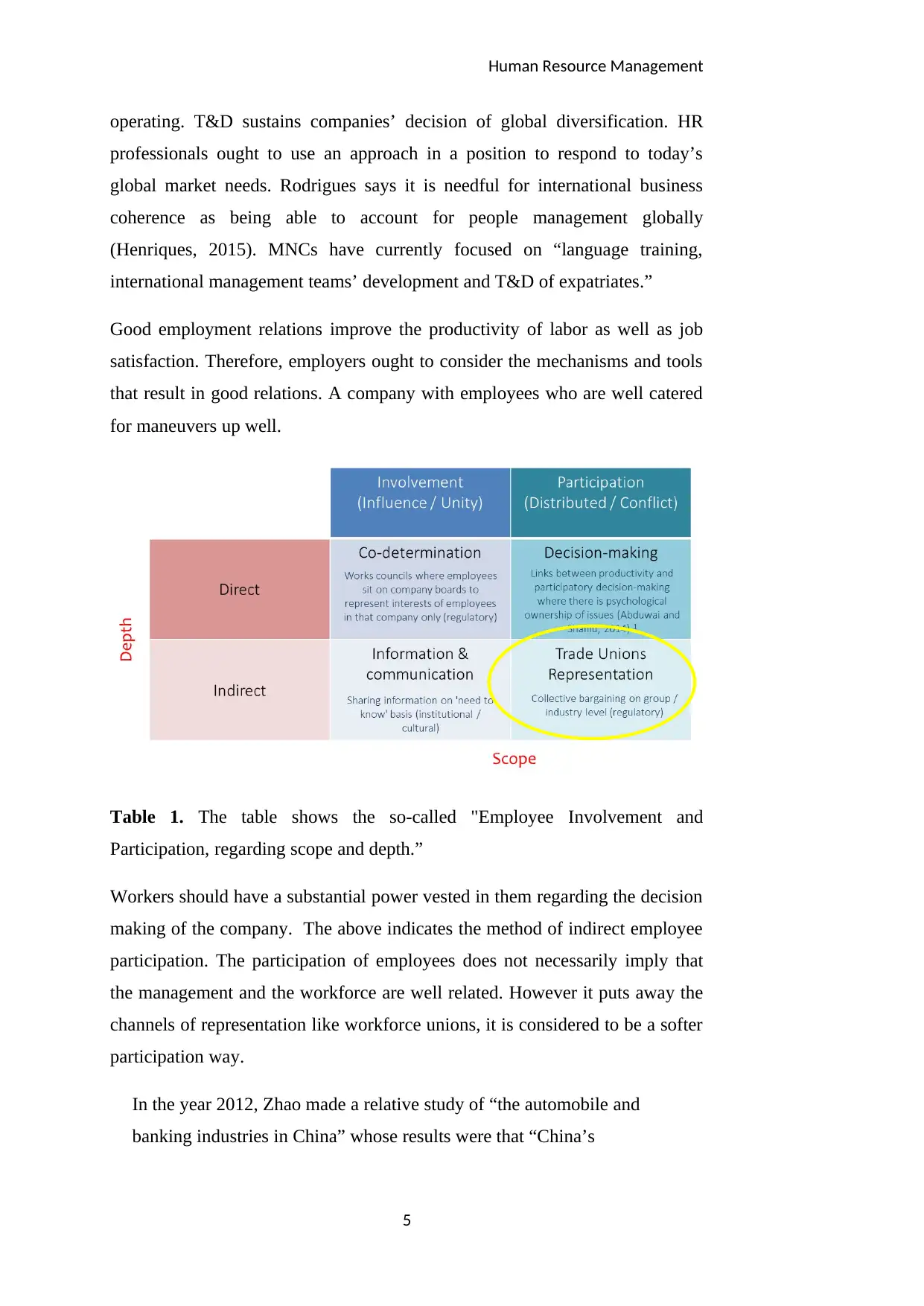
Human Resource Management
operating. T&D sustains companies’ decision of global diversification. HR
professionals ought to use an approach in a position to respond to today’s
global market needs. Rodrigues says it is needful for international business
coherence as being able to account for people management globally
(Henriques, 2015). MNCs have currently focused on “language training,
international management teams’ development and T&D of expatriates.”
Good employment relations improve the productivity of labor as well as job
satisfaction. Therefore, employers ought to consider the mechanisms and tools
that result in good relations. A company with employees who are well catered
for maneuvers up well.
Table 1. The table shows the so-called "Employee Involvement and
Participation, regarding scope and depth.”
Workers should have a substantial power vested in them regarding the decision
making of the company. The above indicates the method of indirect employee
participation. The participation of employees does not necessarily imply that
the management and the workforce are well related. However it puts away the
channels of representation like workforce unions, it is considered to be a softer
participation way.
In the year 2012, Zhao made a relative study of “the automobile and
banking industries in China” whose results were that “China’s
5
operating. T&D sustains companies’ decision of global diversification. HR
professionals ought to use an approach in a position to respond to today’s
global market needs. Rodrigues says it is needful for international business
coherence as being able to account for people management globally
(Henriques, 2015). MNCs have currently focused on “language training,
international management teams’ development and T&D of expatriates.”
Good employment relations improve the productivity of labor as well as job
satisfaction. Therefore, employers ought to consider the mechanisms and tools
that result in good relations. A company with employees who are well catered
for maneuvers up well.
Table 1. The table shows the so-called "Employee Involvement and
Participation, regarding scope and depth.”
Workers should have a substantial power vested in them regarding the decision
making of the company. The above indicates the method of indirect employee
participation. The participation of employees does not necessarily imply that
the management and the workforce are well related. However it puts away the
channels of representation like workforce unions, it is considered to be a softer
participation way.
In the year 2012, Zhao made a relative study of “the automobile and
banking industries in China” whose results were that “China’s
5
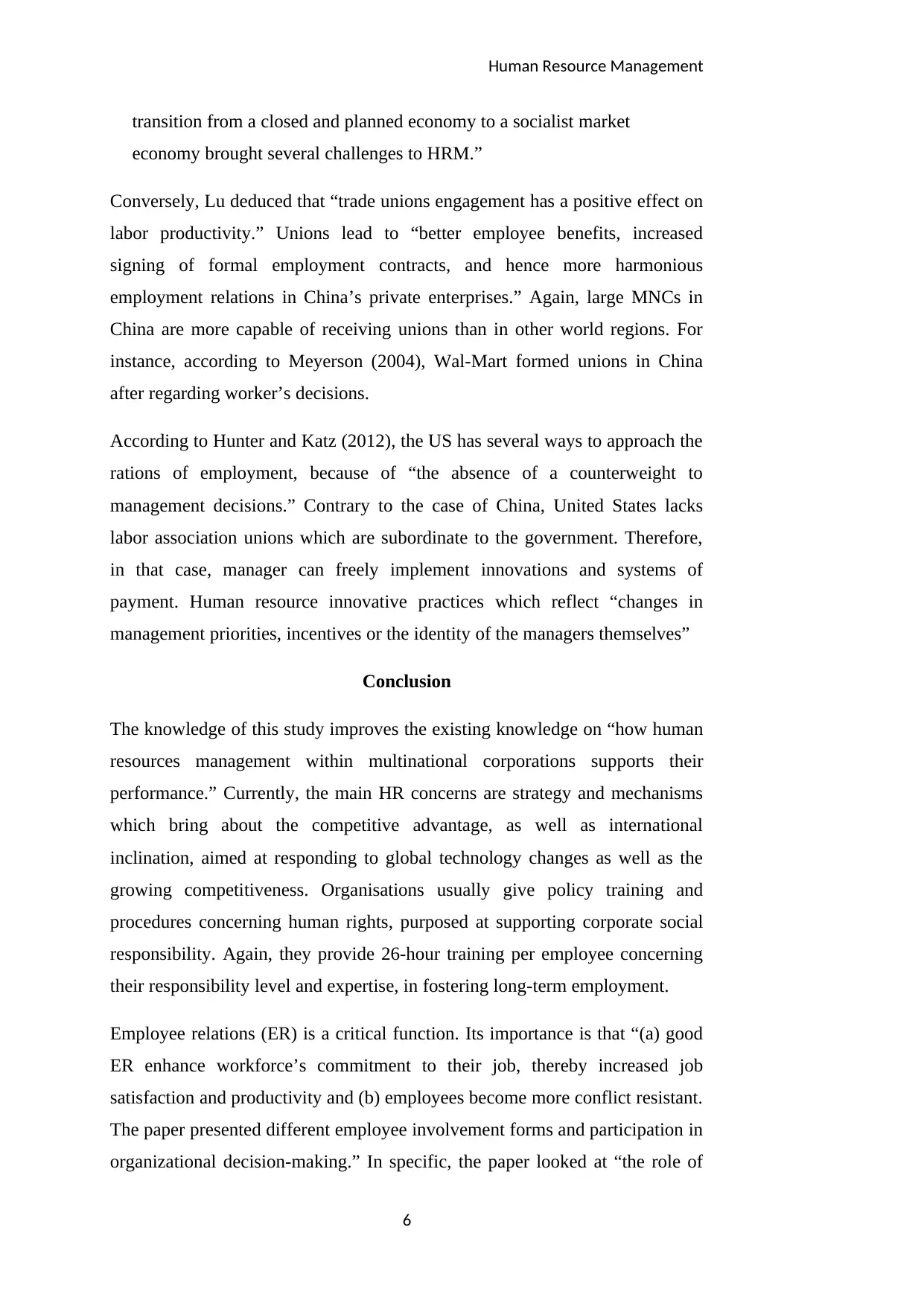
Human Resource Management
transition from a closed and planned economy to a socialist market
economy brought several challenges to HRM.”
Conversely, Lu deduced that “trade unions engagement has a positive effect on
labor productivity.” Unions lead to “better employee benefits, increased
signing of formal employment contracts, and hence more harmonious
employment relations in China’s private enterprises.” Again, large MNCs in
China are more capable of receiving unions than in other world regions. For
instance, according to Meyerson (2004), Wal-Mart formed unions in China
after regarding worker’s decisions.
According to Hunter and Katz (2012), the US has several ways to approach the
rations of employment, because of “the absence of a counterweight to
management decisions.” Contrary to the case of China, United States lacks
labor association unions which are subordinate to the government. Therefore,
in that case, manager can freely implement innovations and systems of
payment. Human resource innovative practices which reflect “changes in
management priorities, incentives or the identity of the managers themselves”
Conclusion
The knowledge of this study improves the existing knowledge on “how human
resources management within multinational corporations supports their
performance.” Currently, the main HR concerns are strategy and mechanisms
which bring about the competitive advantage, as well as international
inclination, aimed at responding to global technology changes as well as the
growing competitiveness. Organisations usually give policy training and
procedures concerning human rights, purposed at supporting corporate social
responsibility. Again, they provide 26-hour training per employee concerning
their responsibility level and expertise, in fostering long-term employment.
Employee relations (ER) is a critical function. Its importance is that “(a) good
ER enhance workforce’s commitment to their job, thereby increased job
satisfaction and productivity and (b) employees become more conflict resistant.
The paper presented different employee involvement forms and participation in
organizational decision-making.” In specific, the paper looked at “the role of
6
transition from a closed and planned economy to a socialist market
economy brought several challenges to HRM.”
Conversely, Lu deduced that “trade unions engagement has a positive effect on
labor productivity.” Unions lead to “better employee benefits, increased
signing of formal employment contracts, and hence more harmonious
employment relations in China’s private enterprises.” Again, large MNCs in
China are more capable of receiving unions than in other world regions. For
instance, according to Meyerson (2004), Wal-Mart formed unions in China
after regarding worker’s decisions.
According to Hunter and Katz (2012), the US has several ways to approach the
rations of employment, because of “the absence of a counterweight to
management decisions.” Contrary to the case of China, United States lacks
labor association unions which are subordinate to the government. Therefore,
in that case, manager can freely implement innovations and systems of
payment. Human resource innovative practices which reflect “changes in
management priorities, incentives or the identity of the managers themselves”
Conclusion
The knowledge of this study improves the existing knowledge on “how human
resources management within multinational corporations supports their
performance.” Currently, the main HR concerns are strategy and mechanisms
which bring about the competitive advantage, as well as international
inclination, aimed at responding to global technology changes as well as the
growing competitiveness. Organisations usually give policy training and
procedures concerning human rights, purposed at supporting corporate social
responsibility. Again, they provide 26-hour training per employee concerning
their responsibility level and expertise, in fostering long-term employment.
Employee relations (ER) is a critical function. Its importance is that “(a) good
ER enhance workforce’s commitment to their job, thereby increased job
satisfaction and productivity and (b) employees become more conflict resistant.
The paper presented different employee involvement forms and participation in
organizational decision-making.” In specific, the paper looked at “the role of
6
⊘ This is a preview!⊘
Do you want full access?
Subscribe today to unlock all pages.

Trusted by 1+ million students worldwide
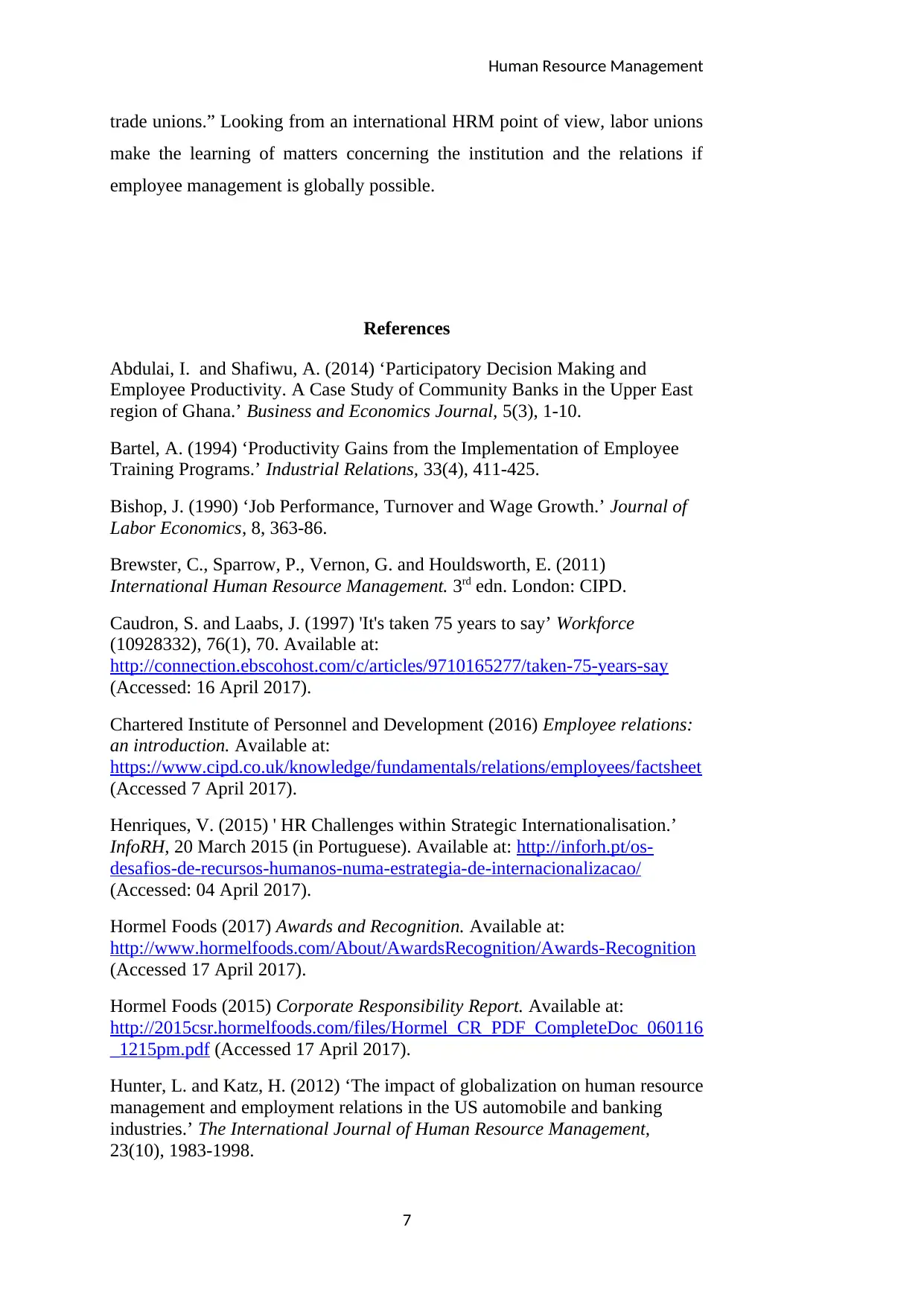
Human Resource Management
trade unions.” Looking from an international HRM point of view, labor unions
make the learning of matters concerning the institution and the relations if
employee management is globally possible.
References
Abdulai, I. and Shafiwu, A. (2014) ‘Participatory Decision Making and
Employee Productivity. A Case Study of Community Banks in the Upper East
region of Ghana.’ Business and Economics Journal, 5(3), 1-10.
Bartel, A. (1994) ‘Productivity Gains from the Implementation of Employee
Training Programs.’ Industrial Relations, 33(4), 411-425.
Bishop, J. (1990) ‘Job Performance, Turnover and Wage Growth.’ Journal of
Labor Economics, 8, 363-86.
Brewster, C., Sparrow, P., Vernon, G. and Houldsworth, E. (2011)
International Human Resource Management. 3rd edn. London: CIPD.
Caudron, S. and Laabs, J. (1997) 'It's taken 75 years to say’ Workforce
(10928332), 76(1), 70. Available at:
http://connection.ebscohost.com/c/articles/9710165277/taken-75-years-say
(Accessed: 16 April 2017).
Chartered Institute of Personnel and Development (2016) Employee relations:
an introduction. Available at:
https://www.cipd.co.uk/knowledge/fundamentals/relations/employees/factsheet
(Accessed 7 April 2017).
Henriques, V. (2015) ' HR Challenges within Strategic Internationalisation.’
InfoRH, 20 March 2015 (in Portuguese). Available at: http://inforh.pt/os-
desafios-de-recursos-humanos-numa-estrategia-de-internacionalizacao/
(Accessed: 04 April 2017).
Hormel Foods (2017) Awards and Recognition. Available at:
http://www.hormelfoods.com/About/AwardsRecognition/Awards-Recognition
(Accessed 17 April 2017).
Hormel Foods (2015) Corporate Responsibility Report. Available at:
http://2015csr.hormelfoods.com/files/Hormel_CR_PDF_CompleteDoc_060116
_1215pm.pdf (Accessed 17 April 2017).
Hunter, L. and Katz, H. (2012) ‘The impact of globalization on human resource
management and employment relations in the US automobile and banking
industries.’ The International Journal of Human Resource Management,
23(10), 1983-1998.
7
trade unions.” Looking from an international HRM point of view, labor unions
make the learning of matters concerning the institution and the relations if
employee management is globally possible.
References
Abdulai, I. and Shafiwu, A. (2014) ‘Participatory Decision Making and
Employee Productivity. A Case Study of Community Banks in the Upper East
region of Ghana.’ Business and Economics Journal, 5(3), 1-10.
Bartel, A. (1994) ‘Productivity Gains from the Implementation of Employee
Training Programs.’ Industrial Relations, 33(4), 411-425.
Bishop, J. (1990) ‘Job Performance, Turnover and Wage Growth.’ Journal of
Labor Economics, 8, 363-86.
Brewster, C., Sparrow, P., Vernon, G. and Houldsworth, E. (2011)
International Human Resource Management. 3rd edn. London: CIPD.
Caudron, S. and Laabs, J. (1997) 'It's taken 75 years to say’ Workforce
(10928332), 76(1), 70. Available at:
http://connection.ebscohost.com/c/articles/9710165277/taken-75-years-say
(Accessed: 16 April 2017).
Chartered Institute of Personnel and Development (2016) Employee relations:
an introduction. Available at:
https://www.cipd.co.uk/knowledge/fundamentals/relations/employees/factsheet
(Accessed 7 April 2017).
Henriques, V. (2015) ' HR Challenges within Strategic Internationalisation.’
InfoRH, 20 March 2015 (in Portuguese). Available at: http://inforh.pt/os-
desafios-de-recursos-humanos-numa-estrategia-de-internacionalizacao/
(Accessed: 04 April 2017).
Hormel Foods (2017) Awards and Recognition. Available at:
http://www.hormelfoods.com/About/AwardsRecognition/Awards-Recognition
(Accessed 17 April 2017).
Hormel Foods (2015) Corporate Responsibility Report. Available at:
http://2015csr.hormelfoods.com/files/Hormel_CR_PDF_CompleteDoc_060116
_1215pm.pdf (Accessed 17 April 2017).
Hunter, L. and Katz, H. (2012) ‘The impact of globalization on human resource
management and employment relations in the US automobile and banking
industries.’ The International Journal of Human Resource Management,
23(10), 1983-1998.
7
Paraphrase This Document
Need a fresh take? Get an instant paraphrase of this document with our AI Paraphraser
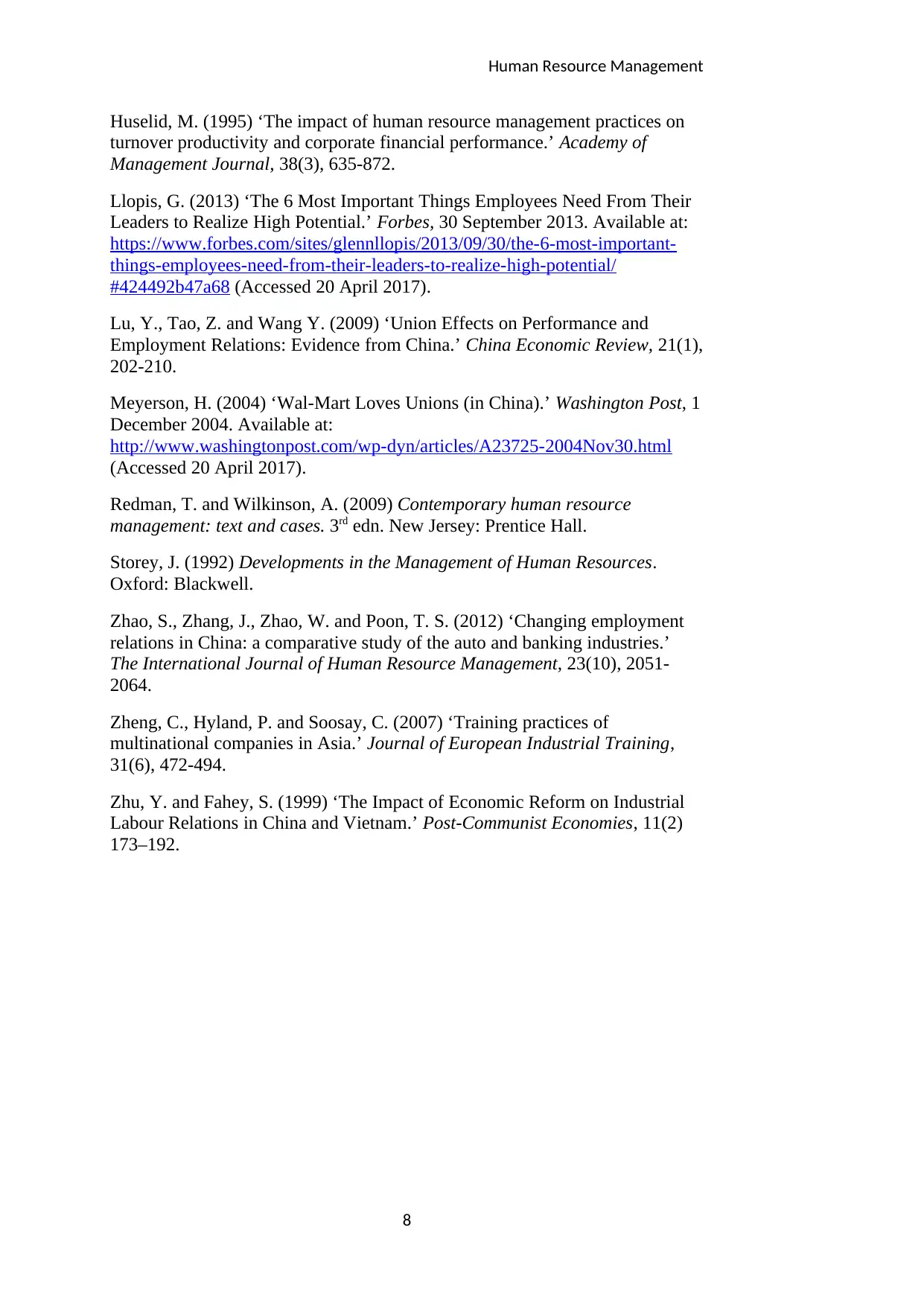
Human Resource Management
Huselid, M. (1995) ‘The impact of human resource management practices on
turnover productivity and corporate financial performance.’ Academy of
Management Journal, 38(3), 635-872.
Llopis, G. (2013) ‘The 6 Most Important Things Employees Need From Their
Leaders to Realize High Potential.’ Forbes, 30 September 2013. Available at:
https://www.forbes.com/sites/glennllopis/2013/09/30/the-6-most-important-
things-employees-need-from-their-leaders-to-realize-high-potential/
#424492b47a68 (Accessed 20 April 2017).
Lu, Y., Tao, Z. and Wang Y. (2009) ‘Union Effects on Performance and
Employment Relations: Evidence from China.’ China Economic Review, 21(1),
202-210.
Meyerson, H. (2004) ‘Wal-Mart Loves Unions (in China).’ Washington Post, 1
December 2004. Available at:
http://www.washingtonpost.com/wp-dyn/articles/A23725-2004Nov30.html
(Accessed 20 April 2017).
Redman, T. and Wilkinson, A. (2009) Contemporary human resource
management: text and cases. 3rd edn. New Jersey: Prentice Hall.
Storey, J. (1992) Developments in the Management of Human Resources.
Oxford: Blackwell.
Zhao, S., Zhang, J., Zhao, W. and Poon, T. S. (2012) ‘Changing employment
relations in China: a comparative study of the auto and banking industries.’
The International Journal of Human Resource Management, 23(10), 2051-
2064.
Zheng, C., Hyland, P. and Soosay, C. (2007) ‘Training practices of
multinational companies in Asia.’ Journal of European Industrial Training,
31(6), 472-494.
Zhu, Y. and Fahey, S. (1999) ‘The Impact of Economic Reform on Industrial
Labour Relations in China and Vietnam.’ Post-Communist Economies, 11(2)
173–192.
8
Huselid, M. (1995) ‘The impact of human resource management practices on
turnover productivity and corporate financial performance.’ Academy of
Management Journal, 38(3), 635-872.
Llopis, G. (2013) ‘The 6 Most Important Things Employees Need From Their
Leaders to Realize High Potential.’ Forbes, 30 September 2013. Available at:
https://www.forbes.com/sites/glennllopis/2013/09/30/the-6-most-important-
things-employees-need-from-their-leaders-to-realize-high-potential/
#424492b47a68 (Accessed 20 April 2017).
Lu, Y., Tao, Z. and Wang Y. (2009) ‘Union Effects on Performance and
Employment Relations: Evidence from China.’ China Economic Review, 21(1),
202-210.
Meyerson, H. (2004) ‘Wal-Mart Loves Unions (in China).’ Washington Post, 1
December 2004. Available at:
http://www.washingtonpost.com/wp-dyn/articles/A23725-2004Nov30.html
(Accessed 20 April 2017).
Redman, T. and Wilkinson, A. (2009) Contemporary human resource
management: text and cases. 3rd edn. New Jersey: Prentice Hall.
Storey, J. (1992) Developments in the Management of Human Resources.
Oxford: Blackwell.
Zhao, S., Zhang, J., Zhao, W. and Poon, T. S. (2012) ‘Changing employment
relations in China: a comparative study of the auto and banking industries.’
The International Journal of Human Resource Management, 23(10), 2051-
2064.
Zheng, C., Hyland, P. and Soosay, C. (2007) ‘Training practices of
multinational companies in Asia.’ Journal of European Industrial Training,
31(6), 472-494.
Zhu, Y. and Fahey, S. (1999) ‘The Impact of Economic Reform on Industrial
Labour Relations in China and Vietnam.’ Post-Communist Economies, 11(2)
173–192.
8
1 out of 8
Related Documents
Your All-in-One AI-Powered Toolkit for Academic Success.
+13062052269
info@desklib.com
Available 24*7 on WhatsApp / Email
![[object Object]](/_next/static/media/star-bottom.7253800d.svg)
Unlock your academic potential
Copyright © 2020–2025 A2Z Services. All Rights Reserved. Developed and managed by ZUCOL.





